Green schools 2018
| 02 Jul 2018 | 01:43
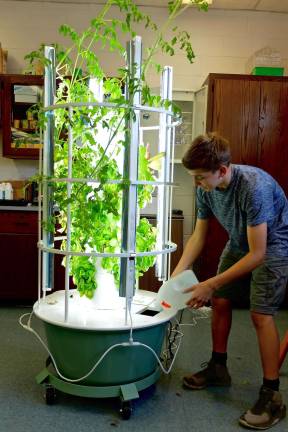
Seventh grader James Burning watering the Grow Tower at Lafayette. Photo by Melissa Shaw-Smith
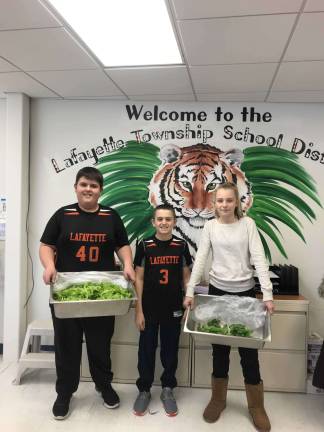
Lafayette students harvested two big trays of lettuce, which were turned into lunch salads, and five pounds of basil.
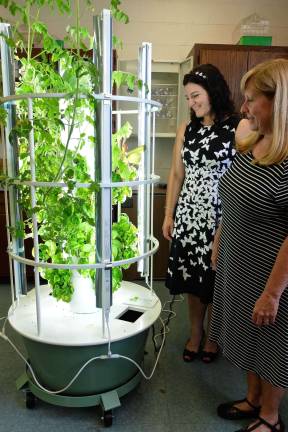
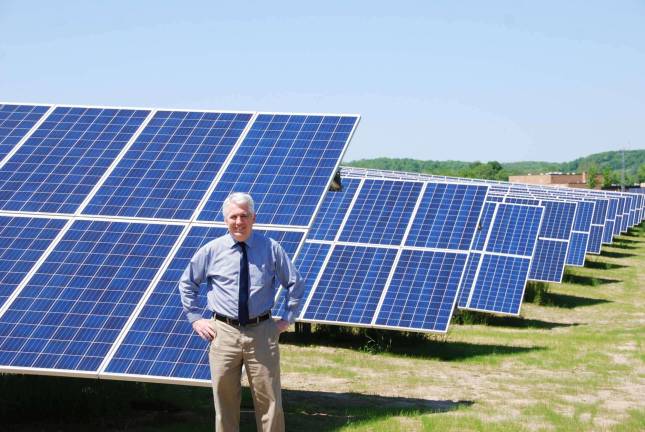
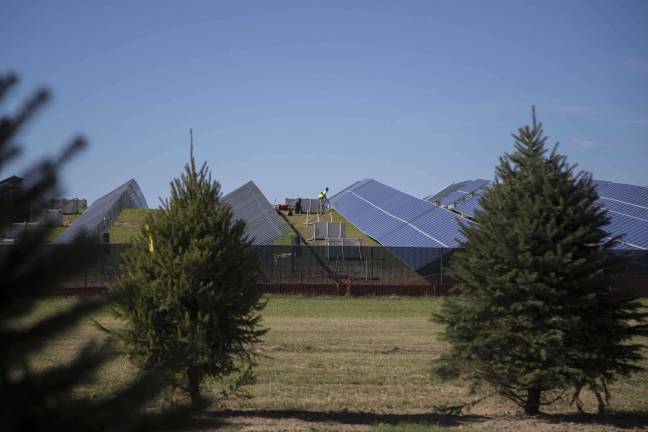

Profile: Lafayette Township School, Lafayette NJ
Raising thinkers, not robots
By Becca Tucker
There are pros to being both principal and superintendent of a small, somewhat isolated school district. The little kids bubble up when they see Jennifer Cenatiempo in the hall (“I like your dress.” “Me too!”), and there’s not much in the way of bureaucracy to contend with when you want to try something new. “We can institute change in a day,” said Cenatiempo, snapping her fingers.
This is her second year on the job at Lafayette Township School, with 230 students in kindergarten through eighth grade. A lot has happened in her short tenure. Her walkie talkie clipped to the pocket of her butterfly dress, she takes this reporter down the hall to see.
First stop is the middle school science classroom, where about a dozen seventh graders sit at desks, working quietly by themselves and in pairs. In the back corner of the room, next to a skeleton wearing a Hawaiian lei, is a glowing, futuristic looking aeroponic garden on wheels. The Sussex County YMCA awarded the school this Grow Tower, valued at $1,107.
From the interior white cylinder grows a jungle of healthy garden plants: basil, Swiss chard, lettuce, bok choi and lanky tomatoes with yellow flowers, but no sign of fruit yet. It is, after all, only the end of May, although for these plants, the season will end with the school year. Students started them from seed and have been harvesting basil and lettuce since October, testing the pH, measuring the plants’ growth, and journaling it all.
“Dec. 1, 2017: Plucked and ate lettuce. It tasted nasty and rubery,” wrote one. Others, like Taylor Bergman, who’s on the cover, liked the basil, which her mom put in a sauce.
One assignment was to write an essay on the question: Could you feed a population this way?
“This could potentially be a way of feeding a future population b/c it is much esier than tending to a garden and seems to grow much faster… You do not have to water the plants yourself either. The Tower has a timer for itself that tells it when to water the plants and I beleve this could be very helpful when growing plants on a busy skedule,” wrote a sixth grader.
With 19 years teaching high school biology under her belt, the science teacher, Nancy Estevez, is well aware of the tomato situation. She fingers a few yellow flowers that have died. In order to get fruit, she’ll have to vibrate the tomato flowers, which she plans to do using a fan, like they do in serious greenhouses.
Tomatoes or no tomatoes, “I’ve been pleasantly surprised with how well this works,” said Estevez, removing a panel to show the tangle of roots inside. The students harvested two big cafeteria trays’ worth of lettuce, which turned into a salad served at lunch, and about five pounds of basil, which went home with students and teachers.
“I made some great pesto,” said Estevez. “One day I had literally two pounds of basil. Two pounds of basil’s a lot.”
It could be a model for a lot of schools, thinks Cenatiempo, and an answer to the challenge that plagues all school gardens in northern climates: you don’t really start harvesting until June, when there are no students. In this digital age, it’s an “important process for kids to see the simplicity of growing food,” she said. “You can have all the tech in the world” – and they have their share, she said, pointing out the 3-D printer – “but if you don’t have farms, you don’t have food. Understanding where your food comes from is an important part of being part of a community.”
Growing food ties into this community particularly, in a district where many students come from farm families or have serious kitchen gardens at home. But some, like sixth grader Brennan McCoy, don’t come green thumb families. “We tried one year,” he said. “All the plants were small.”
The Grow Tower is one of an impressive list of projects spearheaded by teachers around the building to dovetail with the year’s “wellness” theme. The focus on student health, though it may sound vanilla, in fact bucks a national trend. As schools are cutting back on recess and “specials” like art and gym, Lafayette is doubling down on recess and gym, recently added a ceramics studio, and takes field trips to a food pantry where students help serve meals.
The head of the wellness committee, made up of teachers and parents, is school nurse Patricia Faris. The nurse’s office is our next stop – empty at the moment, which is a good sign.
“You know, they come to me a lot because they’re bored,” Faris said. “If they have a stomach ache and what not, that’s a lot of the times a symptom of, they want to get out of the room.”
Faris won a grant a pair of grants from Atlantic Health totaling $550, one for active classrooms and another for farm-to-school initiatives. In addition to “flexible seating” like standing desks, bean bag chairs, and desks with swing bars so kids can swing their legs quietly, Faris now has a collection of wobble seats and yoga balls that teachers can “check out” to use in their classrooms. “We’re dealing with a more and more sedentary group of youngsters,” said Cenatiempo, “but not in Lafayette.” In June, just before the end of the year, the staff was getting ready to put on a farmers market during school. Local farms, includng C&C Growers and Pochuck Valley Farms, would set up their wares on school grounds, and kids would be given fake money to spend on real produce and flowers.
“Most children may not have been to a farmers market,” said Cenatiempo. “We want to encourage that.”
Next up, said Faris, laughing: stress reduction. Indeed, next year’s theme is slated to be social, emotional, and mental health. They have already discussed communicating across subjects to avoid assigning big homework projects at the same time. “Anxiety is at an all-time high,” said Cenatiempo. It’s about “shifting the culture and the climate. It takes baby steps.”

Profile: Warwick School District, Warwick NY
School district lights itself up
By Becca Tucker
Timothy Holmes is snapping photos of the solar panels when I arrive. Solar panels strike me as a notoriously dull photo subject, but beauty is in the eye of the beholder.
“Well here it is, generating money today,” Holmes, assistant superintendent of Warwick Valley Central School District, announces cheerfully. It’s a cloudless May day, and we talk over the low thrum of solar solar inverters. Today, these 10 acres of panels are generating more electricity than the entire school district will use.
Holmes had tried this sort of thing once before. When he was assistant superintendent of Berne-Knox-Westerlo, a small school district near Albany, he’d proposed a solar field. It would have made financial sense, but they “just weren’t down with it,” he said of the community.
So when he got to Warwick and proposed putting a wind turbine on the knoll, and nobody complained, “I was kind of shocked by that,” he said. That project died because the state, which would have funded two-thirds of it, said no. But around that time, the price of solar panels dropped. Warwick has the luxury of lots of land: Sanfordville Elementary School sits on 128 acres, a chunk of which was an unused field inside the cross country track.
A solar field could go right there. You wouldn’t even have to move the track. The superintendent was into the idea. Neighbors were okay with it, too. Although not everyone loves the aesthetic of 10 acres of blue silicon, “our community seems to understand the importance of renewable energy,” said Holmes. Holmes talked to engineers, and the district embarked on the studies: the environmental studies required by the state, the electrical studies for the utility. At least eight thick white binders in Holmes’ office bear testimony to three years of heavy legwork.
Holmes crunched a lot of numbers. Before all else, this had to be a very good investment of $5.7 million. Holmes is a believer in green energy; he points out that the impact of this project is the equivalent of taking 280 cars off the road each year. Still, “if we weren’t making money or at least breaking even, I don’t think we’d do it,” he said. “It’s a lot of work and aggravation.”
At last, in February of this year, Orange & Rockland flipped the switch and the district started making its own power.
On a cloudless May day, Holmes meets me inside the fenced and locked field. He’s snapping photos when I arrive. “Well here it is, generating money today,” he said cheerfully. It hasn’t all been smooth sailing: the utility shut the array down for three weeks in April for what an irritated Holmes called “some phantom problem.”
But today, with the sun beating down, Holmes is optimistic that the 2.4 megawatt solar field will actually perform better than predicted. The budget says the array should pay for for itself in 12.8 years (without taking into account state aid, which is “gravy,” said Holmes.) That all depends on the sun.
Blazing sun means money. It’s punishingly hot in the glare of row upon endless row of slick blue panels. A border of 170 young spruce and pine trees provide a visual screen from the roads and the school, but inside the fence it feels like you could fry. Holmes, though, seems right at home. I don’t know whether it’s on purpose, but his shirt even matches the solar panels. I’m the one to cry uncle and suggest we go talk back at Holmes’ office.
Orange & Rockland buys excess electricity from the district at a rate of 14 to 16 cents per kilowatt/hour – a decent price, says Holmes, that falls with each passing year. That’s why it was a good move to be an early adopter. North Rockland Central School District came to take a walk around the solar field, said Holmes. But it’s not as good a deal now.
“We got in really early. People that waited, it makes it more difficult.” For poorer school districts that get a lot of aid, though, a project like this still makes financial sense, he said.
Along with the voltage have come accolades. Warwick now holds the distinction of owning the largest solar array of any school district in the state, “which is kind of cool,” said Holmes. (There are bigger solar projects at other districts, but they don’t own their systems.) This spring, the U.S. Department of Education named Warwick Valley High School and Park Avenue Elementary Green Ribbon Schools, making Warwick the only district in the state to have two Green Ribbon schools in it.